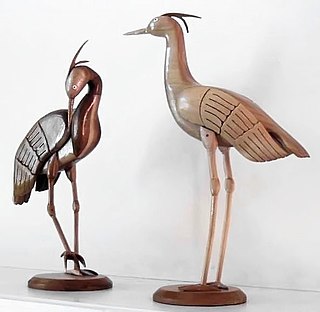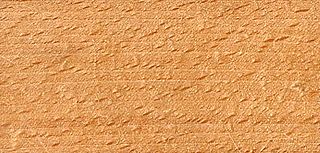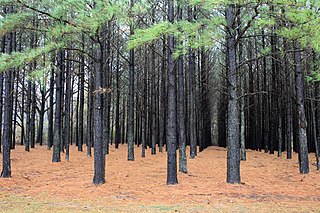
Woodworking is the skill of making items from wood, and includes cabinet making, wood carving, joinery, carpentry, and woodturning.

The Indomalayan realm is one of the eight biogeographic realms. It extends across most of South and Southeast Asia and into the southern parts of East Asia.

Teak is a tropical hardwood tree species in the family Lamiaceae. It is a large, deciduous tree that occurs in mixed hardwood forests. Tectona grandis has small, fragrant white flowers arranged in dense clusters (panicles) at the end of the branches. These flowers contain both types of reproductive organs. The large, papery leaves of teak trees are often hairy on the lower surface. Teak wood has a leather-like smell when it is freshly milled and is particularly valued for its durability and water resistance. The wood is used for boat building, exterior construction, veneer, furniture, carving, turnings, and other small wood projects.

Hardwood is wood from dicot trees. These are usually found in broad-leaved temperate and tropical forests. In temperate and boreal latitudes they are mostly deciduous, but in tropics and subtropics mostly evergreen. Hardwood contrasts with softwood.

Tectona is a genus of tropical hardwood trees in the mint family, Lamiaceae. The three species are often collectively called teak.
The following outline is provided as an overview of and guide to forestry:
Teak wood is used for making boats, furniture, and other things which require resistance to the elements. Teak is used for outdoor furniture but is not recommended for full exposure to sunlight. Being more expensive than most other woods, teak furniture has become something of a status symbol. Not only is it common for a teak bench, chair, or table to last 70 years with the correct care plan, it is also common to pass down such furniture to future generations as an heirloom.

Although tropical Africa is mostly familiar to the West for its rainforests, this biogeographic realm of Africa is far more diverse. While the tropics are thought of as regions with warm to hot moist climates caused by latitude and the tropical rain belt, the geology of areas, particularly mountain chains, and geographical relation to continental and regional scale winds impact the overall parts of areas, also, making the tropics run from arid to humid in West Africa. The area is experiencing negative effects of rapid human population growth.

Milicia excelsa is a tree species from the genus Milicia of the family Moraceae. It is one of two species yielding timber commonly known as African teak, iroko, intule, kambala, moreira, mvule, odum and tule.
Rubberwood is a light-colored medium-density tropical hardwood obtained from the Pará rubber tree, usually from trees grown in rubber plantations. Rubberwood is commonly advertised as an "environmentally friendly" wood, as it makes use of plantation trees that have already served a useful function.

Forestry in India is a significant rural industry and a major environmental resource. India is one of the ten most forest-rich countries of the world. Together, India and these other 9 countries account for 67 percent of total forest area of the world. India's forest cover grew at 0.20% annually over 1990–2000, and has grown at the rate of 0.7% per year over 2000–2010, after decades where forest degradation was a matter of serious concern.

Deforestation is one of the most serious environmental issues in Sri Lanka. Sri Lanka current forest cover as at 2017 was 29.7%. In the 1920s, the island had a 49 percent forest cover but by 2005 this had fallen by approximately 26 percent. Between 1990 and 2000, Sri Lanka lost an average of 26,800 ha of forests per year. This amounts to an average annual deforestation rate of 1.14%. Between 2000 and 2005 the rate accelerated to 1.43% per annum. However, with a long history of policy and laws towards environmental protection, deforestation rates of primary cover have actually decreased 35% since the end of the 1990s thanks to a strong history of conservation measures. The problem of deforestation in Sri Lanka is not as significant in the southern mountainous regions as it is in northern and lowland southern Sri Lanka, largely due to the nature of environmental protection.
Proteak is a forestry company that cultivates teak trees on plantations located on reclaimed ranch lands in the dry tropical regions of Mexico and Latin America. Based out of Mexico City, Mexico, Proteak has satellite offices in Wimberley, Texas and Tepic, Mexico. At their manufacturing facilities, Proteak produces a range of teak products including: cutting boards, butcher blocks, decking, flooring and lumber.

Farming Systems in India are strategically utilized, according to the locations where they are most suitable. The farming systems that significantly contribute to the agriculture of India are subsistence farming, organic farming, industrial farming. Regions throughout India differ in types of farming they use; some are based on horticulture, ley farming, agroforestry, and many more. Due to India's geographical location, certain parts experience different climates, thus affecting each region's agricultural productivity differently. India is very dependent on its monsoon cycle for large crop yields. India's agriculture has an extensive background which goes back to at least 9 thousand years. In India, Agriculture was established throughout most of the subcontinent by 6000–5000 BP. During the 5th millennium BP, in the alluvial plains of the Indus River in Pakistan, the old cities of Mohenjo-Daro and Harappa experienced an apparent establishment of an organized farming urban culture. That society, known as the Harappan or Indus civilization, flourished until shortly after 4000 BP; it was much more comprehensive than those of Egypt or Babylonia and appeared earlier than analogous societies in northern China. Currently, the country holds the second position in agricultural production in the world. In 2007, agriculture and other industries made up more than 16% of India's GDP. Despite the steady decline in agriculture's contribution to the country's GDP, agriculture is the biggest industry in the country and plays a key role in the socio-economic growth of the country. India is the second-largest producer of wheat, rice, cotton, sugarcane, silk, groundnuts, and dozens more. It is also the second biggest harvester of vegetables and fruit, representing 8.6% and 10.9% of overall production, respectively. The major fruits produced by India are mangoes, papayas, sapota, and bananas. India also has the biggest number of livestock in the world, holding 281 million. In 2008, the country housed the second largest number of cattle in the world with 175 million.

Futuro Forestal S.A. is a German-Panamanian reforestation company that operates in Latin America. It was founded 1994 in Panama and headquartered in Panama City. Futuro Forestal is the first impact investment management company of the tropical forestry industry. To date the company has planted over 8,000 hectares of teak and mixed hardwood plantations on deforested pastureland, often under the Forest Stewardship Council (FSC) standard.
According to a report by the Food and Agriculture Organization of the United Nations, Myanmar lost 19%, or 7,445,000 hectares, of forest between 1990 and 2010. With forest covering as much as 70% of Burma at the time of independence, there were only slightly more than 48% forest cover left as of 2014. The deforestation rate of Myanmar has declined from 0.95% per year in the years 1990–2010 to about 0.3% per year and deforestation in Myanmar is now less than other countries of the region such as Indonesia or Vietnam, but still remains an important environmental issue. Three main factors contribute to continued deforestation: unsustainable and illegal logging, unresolved land rights and land disputes and extensive agricultural development.
The wood industry or lumber industry is the industry concerned with forestry, logging, timber trade, and the production of primary forest products and wood products and secondary products like wood pulp for the pulp and paper industry. Some of the largest producers are also among the biggest owners of timberland. The wood industry has historically been and continues to be an important sector in many economies.

Teak, tectona grandis, is a hardwood tree native to much of South and Southeast Asia, including Myanmar. Due to its natural water resistance, teak is sought out for a variety of uses including furniture-making and shipbuilding. Teak grows throughout much of Burma, but was first exploited in the Tenasserim region in the southeast of Burma on the Malay Peninsula Though it has long been used by locals, teak has been important to the economy of Myanmar since British Colonization and remains a political issue today.

Rice production in Myanmar accounts for approximately 43% of total agricultural production in the country, making it the seventh largest producer of rice in the world. Out of 67.6 million hectares of land, 12.8 million are used for cultivation. In 2019 alone, Myanmar accounted for 13,300 million metric tons of milled rice production.

A tree plantation, forest plantation, plantation forest or timber plantation is a forest planted for high volume production of wood, usually by planting one type of tree as a monoculture forest.













